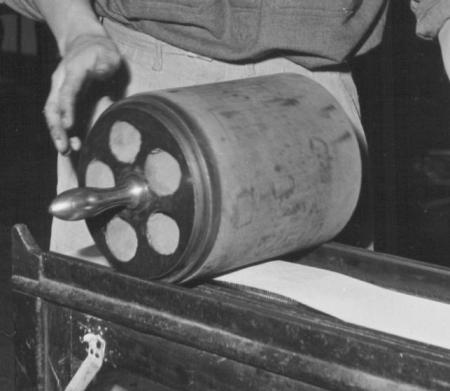Galley Proof Presses
Attached is a cropped picture of a Galley Proof Press in operation in the 1940’s, showing the impression cylinder. I’ve seen this picture before and numerous others of these presses, but I’ve never actually seen one in real life. I’ve got a few questions about them:
1. The cylinders always have a felt covering on them. What type of felt is it? Specifically, how thick is it and how hard/dense is it?
2. In this picture, the cylinder appears to be filled with concrete or plaster….. apparently to make it heavier. Other pictures I’ve seen show a holllow cylinder. How heavy is the cylinder on an old Golding or Miles Nerviene Galley Press? How heavy should it be?
3. I always see these presses noted as “strictly for proofing only” and so forth, BUT I have recently discovered some excellent woodcuts that were apparently printed during the 1920’s on such a machine….. which makes me wonder about the “current opinion” of their capability. How do we really know that the press type is incapable of fine work? With a suitable tympan frame, and correct set-up, it might just print OK. Or maybe not. I don’t know.
Has anyone here actually used or tried to use one of these presses? If so, how did it work and what were the problems encountered?

cropped 1.jpg
To Winking Cat Press - I have proofed on a C & P Galley Proof Press,16” x 31”. In answer to your inquiries:
1. The C & P has a very thin felt cover and is very firm.
2. The cylinder on the C & P is hollow but quite heavy. I can lift it, but it is easier with two people.
3. As for fine work, the biggest problem would be the registration.
4. As to using a tympan, it would ahve to be laid on longwise as the cylinder runs on rails inside the edge of the bed.
5. Finally, they print going in either direction so you would have to double strike with a tympan.
I hope this helps. Howard H.
Howard- thanks for the info. From your description, I’m guessing that the cylinder weighs somewhere between 50 and 100lbs or just a bit more, which seems about right to me.
Registration does look like it could be a problem for these presses….. but not an unsurmountable one. It appears that the Artiste’s of the world have several methods of achieving close register on their roller presses that would work fine on a Galley Proof Press.
Pondering the tympan thing, you are right. It would have to lay inside the rails, which would then encroach on the available print area. That would not be a good thing.
Your info and comments have been very helpful. Thank you.
Dave
Winking Cat Press
I have a C&P galley proof press like the one dave used. I use it for proofing, but have replaced the felt with a packed tympan which is wired in place. I must be careful to avoid the wires, but otherwise works fine. I went with the standard packing for two reasons:
1. I didn’t at the time have a source for the hard felt
2. I wanted to have a harder surface for proofing type so I could see any defects in the individual letters before getting to the production press.
I often use carbon paper to proof galleys to avoid having to roll up ink, but sometimes do use ink to make a better looking proof.
There are several people who use Poco proof presses for all their printing. At least one has attached a tympan and frisket frame to allow precise positioning and another has used graphic arts film register pins, punching the sheets before printing to allow accurate color register, then the portion of the sheet with the holes is cut off and discarded after printing.
n/a